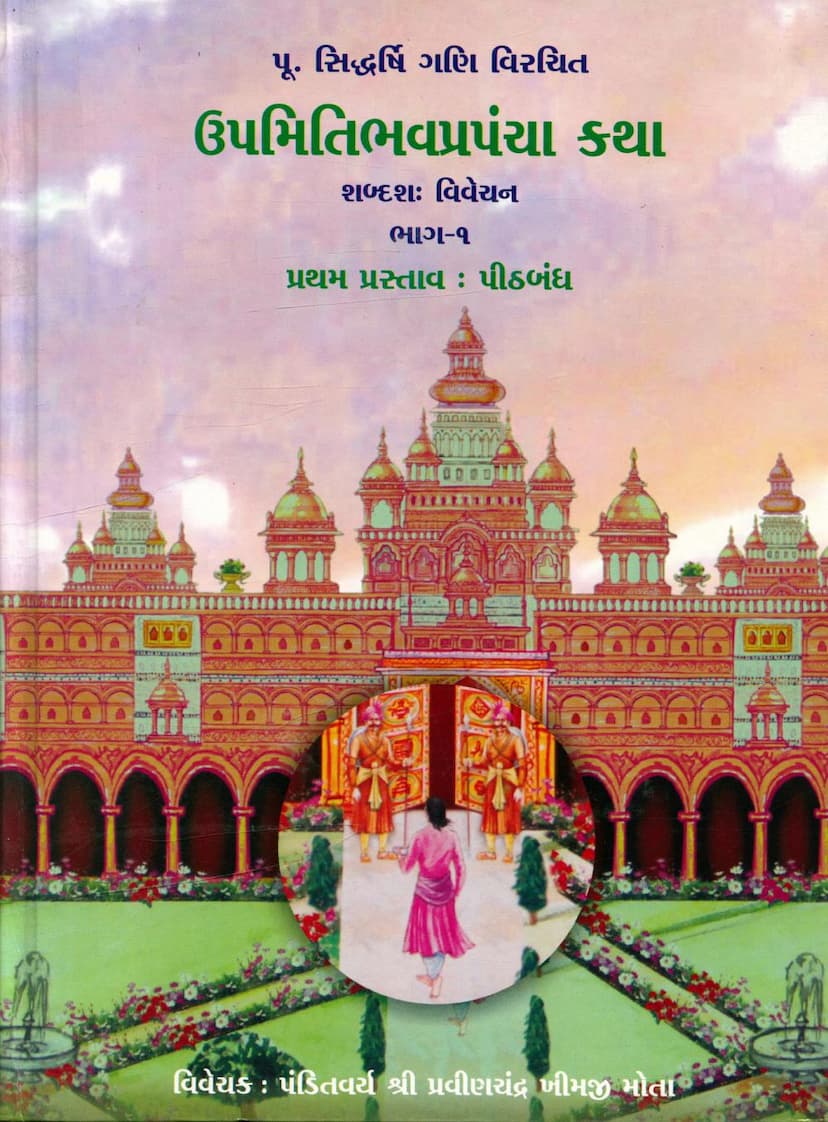Upmiti Bhav Prapancha Katha Part 01
Added to library: September 2, 2025

Summary
Here's a comprehensive summary of the provided Jain text, "Upmiti Bhav Prapancha Katha Part 01," based on the translated content and the structure indicated by the pages:
Book Title: Upmiti Bhav Prapancha Katha Part 01 (ઉપમિતિભવપ્રપંચા કથા ભાગ-૧) Author: Pravin K Mota (Author of the commentary/analysis, with the original work by Siddharshi Gani) Publisher: Gitarth Ganga
Overall Summary:
This book, "Upmiti Bhav Prapancha Katha Part 01," is a "Shabdashah Vivechan" (word-for-word commentary and analysis) of the first part of the original work by Acharya Siddharshi Gani. The title itself, "Upmiti Bhav Prapancha Katha," translates to "The Story of the Illusion of the Worldly Cycle through Simile." This first part focuses on "Peethbandh" (પીઠબંધ), which serves as the introductory or foundational section. The commentary is authored by Pandit Praveenchandra Khimji Mota, aiming to elucidate the profound philosophical and spiritual teachings embedded within Siddharshi Gani's classic work.
Key Aspects and Content:
The provided pages indicate the following key aspects of this volume:
-
Original Author and Commentary:
- Original Text Author: Acharya Siddharshi Gani (પૂ. સિદ્ધર્ષિ ગણિ), described as a "Vyakyantruchuḍāmaṇi" (master commentator) and "Mānasashāstravid" (psychologist).
- Commentator (Vivechak): Panditvaray Shri Praveenchandra Khimji Mota (પંડિતવર્ય શ્રી પ્રવીણચંદ્ર ખીમજી મોતા).
- Inspiration and Guidance: The work is blessed by the teachings of Acharya Shrimad Vijay Ramchandrasurishwarji Maharaj and Muni Pravar Shrimad Mohjit Vijayji Maharaj, and inspired by Acharya Bhagwant Shrimad Vijay Yugbhushansurishwarji Maharaj.
-
Purpose and Philosophy:
- The core purpose of the Upmiti Bhav Prapancha Katha is to illustrate, through similes and allegorical narratives, how worldly existence (Bhava Prapancha) is characterized by the cycle of births and deaths (Bhava), driven by passions (Kashayas) and secondary passions (Nokashayas).
- The text aims to guide the reader towards liberation (Moksha) by explaining the nature of inner qualities and inner faults, using comparisons with cities and other imagery.
- The commentary emphasizes the need for deep knowledge of Jain philosophy (Jinvachana) beyond mere attainment of the faith. True benefit comes from understanding the profound secrets of the teachings, cultivating unwavering respect for the faith, and making a firm resolution towards the path of spiritual practice (Sadhana).
-
Structure of the Work (as per the Index/Anukramanika):
- The first part, "Peethbandh," focuses on the introductory aspects of the narrative. This includes:
- The author's invocation and introductory verses (Mangalacharan).
- The purpose and significance of the scripture.
- Classifications of narratives (Katha Bhedo).
- Types of listeners (Shrotru Bhedo).
- Praise of narratives (Kathao ni Prashansati).
- Discussions on the authority and context of the narrative.
- A brief overview of the Upmiti Bhav Prapancha Katha's essence.
- Allegorical descriptions of worldly concepts (e.g., Mahapur city, a beggar, the palace).
- The allegorical representation of the soul's journey through different states of existence (hell, animal, human, divine realms) and the role of suffering (Vedana).
- The importance of discerning the good (Sajjan) from the bad (Durjan).
- The core narrative begins with the story of the king Anusundar and the beggar Nishpunyak, illustrating the impact of divine grace and the path to spiritual understanding.
- The first part, "Peethbandh," focuses on the introductory aspects of the narrative. This includes:
-
Commentary Style:
- The commentary is a "Shabdashah Vivechan," meaning it provides a detailed word-for-word analysis.
- It incorporates explanations of Sanskrit terms, often using the '=' sign to equate them with their meaning in Gujarati.
- The commentary aims to be accessible to both those familiar with Sanskrit and those who are not, although it notes that those unfamiliar might find it slightly challenging but solvable by understanding the context.
-
Publisher and Availability:
- The publisher is Gitarth Ganga, located in Ahmedabad.
- The book is presented as a gift to the knowledge repository/Sangh.
- The publication date is noted as Veer Samvat 2540 + Vikram Samvat 2070, indicating a modern publication.
- Contact information and online presence are provided for obtaining the book.
In essence, the first part of this commentary on Upmiti Bhav Prapancha Katha sets the stage for the allegorical narrative. It meticulously breaks down the foundational concepts, the story's purpose, and the author's philosophical framework, all explained in detail by Pandit Praveenchandra Mota, guided by the wisdom of revered Jain Acharyas.